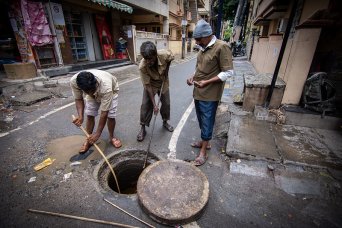- About
- Topics
- Picks
- Audio
- Story
- In-Depth
- Opinion
- News
- Donate
- Signup for our newsletterOur Editors' Best Picks.Send
Read, Debate: Engage.
| topic: | Health and Sanitation |
|---|---|
| located: | India |
| editor: | Hanan Zaffar |
Even in the 21st century, when almost every aspect of modern lives is made highly convenient by advanced technology, thousands of people continue to clean human waste and excreta with their bare hands. While this is blatantly a denial of the basic right of dignity by the standards of any society, it is unfortunately a norm in India.
Thousands of people known as “manual scavengers,” who belong to marginalised social groups, engage in the cleaning and disposition of human excreta from pits or from unsanitary latrines. According to data from the Indian government, these manual scavengers amount to about 58,098 people across the country; however, activists and experts put the estimation much higher.
As a degrading and dangerous practice, manual scavenging is a violation of human rights and goes against the Indian constitutional right to live life with dignity. It suppresses the so-called ‘lower caste’ people who participate in it and compels them to live a humiliating life. These individuals are discriminated against in every sphere of daily activity: in healthcare, education, and access to daily amenities, and they suffer from the psychological consequences of social ostracisation and stigmatisation.
This social attitude does not only reflect the value attached to these people’s dignity, but has also demonstrated the value attached to their life. According to the Safai Karmachari Andolan - a national movement for eradicating the practice of manual scavenging - 472 deaths occurred due to manual scavenging between 2016 to 2020.
The practice is a living example of the stringent caste system as the task of cleaning human waste is performed by people who are in the ‘lowest of the lowest’ classes. As per the UN, “The practice of manual scavenging is linked to India’s caste system where so-called lower castes were expected to perform this job. Manual scavengers are amongst the poorest and most disadvantaged communities in India.” A staggering 98 percent of people involved in manual scavenging are those belonging to lower castes or are women.
Even though India has passed legislation, conducted surveys, and implemented rehabilitation programmes in a bid to eradicate this practice, little has been implemented on the ground. The Employment of Manual Scavengers and Construction of Dry Latrines (Prohibition) Act of 1993 and the Prohibition of Employment as Manual Scavengers and their Rehabilitation Act of 2013 (PEMSRA) not only prohibit the practice but also penalise those who hire people to clean human excrement.
Despite this, there are still 2,600,000 dry-latrines in the country which require humans to remove the excreta from them, almost 770,000 manual scavengers who physically clean the sewers and drains and about 8,025 manual scavengers operating at railway stations in the country.
The government last month stated that no person had died from manual scavenging in the country in the previous three years (2019 to 2022). However, it ironically mentioned that a total of 233 people had died “due to accidents while undertaking hazardous cleaning of sewer and septic tanks” in the same time period.
Despite the availability of alternatives, like modern mechanised pumps, the authorities continue to keep this dangerous practice alive. The pumps available are an efficient and convenient tool to clean the dirty drains and unblock the clogged sewers that otherwise require a human to dive into. However, the unplanned design of these drains and sewers, along with a less costly manual method of cleaning, results in the continued use of people. Over and above, with no financial security or societal acceptance, manual scavengers are forced to continue working despite the legislative ban on the practice.
Photo by Sharada Prasad CS

